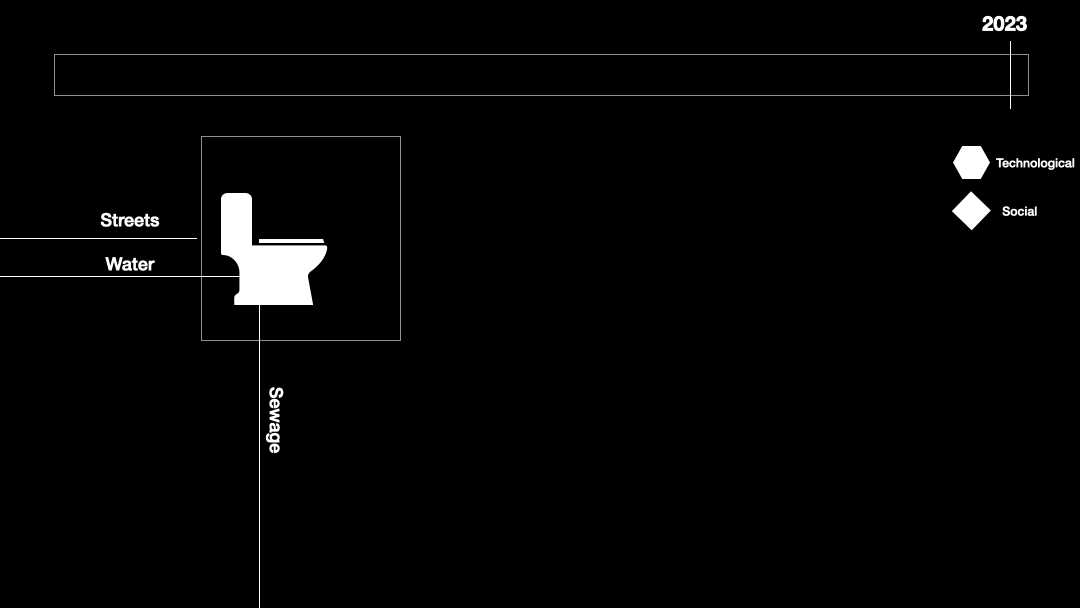
Flushing Down Data
The mundane act of flushing a toilet unveils a remarkable journey of data collection and analysis. In this exploration, we delve into how everyday sewage systems serve as a reservoir of valuable information, offering insights into public health, societal trends, and environmental impacts.
Join as we unravel the complexities and possibilities of harnessing this often-overlooked source of data, illuminating the profound connections between our daily routines and the broader world of information.
History of Public Toilets
Toilet Tales: A Sociotechnical Evolution Through the History of Public Pay Toilets" by Kate Kagioglidis
An essay that explores the fascinating journey of public toilets from Ancient Rome to contemporary times. It delves into the sociotechnical complexities of public sanitation, tracing back to the taxation of urine in Ancient Rome and the emergence of Sanifair restrooms in modern Germany. With humor and insight, the essay highlights the societal and technological shifts that have shaped public restroom infrastructure, from the era of the "Abtrittanbieterin" in 19th-century Hamburg to the rise and fall of pay toilets in 20th-century America. The narrative culminates in a discussion of the early 21st-century developments in restroom technology, revealing the hidden labor and economic dynamics behind the seemingly mundane act of relieving oneself. Through meticulous research and engaging storytelling, "Toilet Tales" offers a thought-provoking exploration of the intersections between design, accessibility, and social norms throughout history.
Infrasructure of a Toilet
Yes, even today, the humble toilet remains an integral part of our lives, nestled within buildings connected by streets and intricate infrastructures. Each flush consumes approximately 14,300 litres of water per person annually, while the upkeep of a home toilet demands around 10 hours per year. With a basic toilet priced at around 300 Euro, calling a plumber can incur additional costs of 60 Euro per hour, not to mention the expenses of repairs. And let's not overlook the essential necessity of toilet paper, with an average of 81 rolls per person per year in Spain alone, illustrating the significant disparities in toilet-related practices and expenses across countries.
But that’s just the beginning.
For example the journey of a simple toilet roll extends far beyond its purchase at the supermarket. It begins with production, involving intricate processes at a toilet paper factory, which in turn relies on paper pulp from a wood mill. And before that, a tree is felled. What highlights the interconnectedness of various infrastructures.
If you want to know more about toilet paper check out:
Data of your Toilet Business
What do we know about the intimate act of answering nature's call? It's a basic human function, yet it's deeply personal and varied in its manifestations. We're familiar with the basics: where it happens, whether in a public restroom or the comfort of home; when it occurs, sometimes disrupting sleep patterns; how it feels, and even the sounds that accompany it, from the mundane to the sophisticated systems of Japan.
We're attuned to the sights, smells, and yes, even tastes associated with the process. While today we no longer need to resort to tasting urine to diagnose medical conditions like diabetes, historical anecdotes remind us of the remarkable ways in which our understanding has evolved.
“„The urine of a diabetic patient tastes wonderfully sweet as if it were imbued with honey or sugar.””
Today, advancements in technology allow for non-invasive and convenient methods of urine analysis, empowering individuals to monitor their health from the comfort of home. From simple urine tests available online to complex biomarker analysis, the scope of what can be gleaned from urine is vast, encompassing indications of pregnancy, infection, kidney function, and even certain cancers. It's a testament to the interconnectedness of science, medicine, and society, with each advancement reflecting and shaping our understanding of human health and well-being. And if you've ever had to hand over a cup of urine, here's hoping it was to your doctor and not a curious police officer!
(One possible) Future of your Toilet Buisiness
Smart Toilets
Enter the realm of smart toilets, where cutting-edge technology meets the most intimate aspects of daily life. Stanford researcher Sanjiv "Sam" Gambhir has been at the forefront of this technology, unveiling prototypes that surpass conventional urine analysis methods—a feat accomplished as far back as 2020. Gambhir assures us of stringent privacy measures, emphasizing the anonymization of data sent to the cloud and its protection when shared with healthcare providers. He envisions the smart toilet as a revolutionary health-monitoring tool, requiring no alteration to user habits. Yet, the idea of seamless data collection without user intervention raises valid concerns about privacy and autonomy. While the promise of smart toilets looms large, it's a reminder that widespread adoption is still a future aspiration, not a present reality.
“The user doesn’t have to do anything differently.”
From waterpumps to wastewater
Recall Dr. John Snow's landmark 1854 case linking London's water system to cholera outbreaks, highlighting how infrastructure impacts public health. Since then, scientific advances, like Pacini's cholera bacterium identification and Trask and Dr. John Paul's polio surveillance, have deepened our understanding. Today, sewage, analyzed with PCR since the 1990s, provides crucial data, notably during the COVID-19 pandemic for infection tracking. Wastewater surveillance, seen in the US and the Netherlands, enables targeted interventions. Beyond pathogens, sewage analysis reveals drug residues, offering insights into societal trends. This extensive data prompts questions on governance and implications. Who benefits from this information?
But who benefits from this information?
“Policies regarding privacy have been historically reactive instead of proactive. [..] We know that the pace of innovation has outpaced the ability of social and legal mechanisms to keep up.”
“This [waste water surveilance] might become one of the most common and invasive forms of surveillance in the coming years.”
It’s our everyones business.
Thank you and happy business.
Sources
Ancient Origins. (n.d.). The Urine Wheel and Uroscopy: Your Wee Could Tell a Medieval DoctorCameron,
Cameron, J. S. (2015). A history of urine microscopy: From ancient traditions to modern diagnostics. In Clinical Chemistry and Laboratory Medicine (pp. 2045-2052). De Gruyter.
Berger, M., & Herzig, C. (2015). History of urine microscopy: From ancient traditions to modern diagnostics. Clinical chemistry and laboratory medicine, 53(12), 2045-2052.
Bosch, T., van Beek, E., & Kooiker, M. (2015). Viral and bacterial RNA in sewage and surface water: Detection and potential use for public health. Current Environmental Health Reports, 2(4), 241-252.
Business Insider. (2020, April 20). Scientists designed a smart toilet with butt-recognition technology.
Ebikeme, S., & Onwurah, I. N. (2015). A comprehensive review on wastewater as a source of information on the health of a community: A Nigerian perspective. Science of the Total Environment, 524-525, 48-67.
Gambhir, S. K. (2020). A smart toilet for precision health. Nature Biomedical Engineering, 4(4), 327-335. doi:10.1038/s41551-020-0428-5
Harvard Medical School. (2018). Pee and the pregnant woman: A history of science behind urine-based pregnancy tests. Science in the News.
Harvard Medical School. (2023). Something in the Sewage: What Watching Our Wastewater Can Tell Us About Infectious Diseases. Science in the News - Harvard University
International Water Association. (2021). Life cycle assessment of toilets. IWA Publishing.
Johnson, Steven. (2006). The ghost map: The story of London's most terrifying epidemic—and how it changed science, cities, and the modern world. Riverhead Books.
J. S. (2015). A history of urine microscopy. In Clinical Chemistry and Laboratory Medicine (pp. 2045-2052)
Miller, J. C., & Nardin, A. (2009). The cholera pumps in London in 1854: A reinterpretation. Journal of Urban History, 35(5), 959-980.
Tani, S. (2017, November 29). The washlet revolution: How Japanese toilets became the world's most advanced. The Wall Street Journal.
The Japan Times. (2019, November 20). The sound of relief: The rise of Japanese toilets with built-in sound systems.
Public Domain Review. (n.d.). Troubled Waters: A History of Sanitation in Medieval England.
QS Supplies. (2022, May 2). World Toilet Paper Consumption Visualised.
UCLA Fielding School of Public Health. (n.d.). John Snow and the Broad Street Pump: On the Trail of an Epidemic.
United States Environmental Protection Agency. (2022). Toilet water use: A review of literature. EPA 600/R-12/063.
van der Veer, W., & de Wit, M. (2015). De Nederlandse urinekalender: Een overzicht van de ontwikkelingen op het gebied van urine-onderzoek en -behandeling in Nederland. RIVM
Wolpert, S. (2014, November 19). The science behind Japanese toilet technology. Popular Science.
World Resources Institute. (2023). The environmental impact of toilets.







